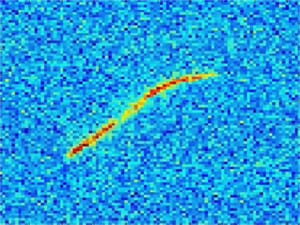
Dispersing Single-Walled Carbon Nanotubes (SWNTs) in water is challenging because they are held together by strong van der Waals forces. Most commonly, SWNTs are stabilized sterically or electro-statically by adsorbing surface active molecules on their sidewalls. Stabilization must be combined with mechanical debundling, usually by sonication (impingement with high-energy sound-waves).
We are studying the behavior of individual SWNTs in fluids as well as the overall behavior of SWNT fluid phases. We visualize SWNTs by videomicroscopy both by introducing fluorescent dyes and also using near-infrared fluorescence (a technique developed by Prof. Weisman). We are currently exploring the interplay of SWNT elasticity and Brownian motion at the nano-scale, both in simple fluids (water) and confined spaces (networks and porous media). We are also interested in new ways of entrapping SWNTs into stable micelles; we have shown that it is possible to combine surfactants and polymers to stabilized SWNTs in water while isolating them from their surrounding environment, so that they maintain their fluorescence and electronic properties in acidic and biological environments. We are also studying the interaction of SWNTs with electromagnetic fields (microwave, UV and AC electrical fields); in this area, the extreme anisotropy and polarizability of SWNTs has created exciting avenues of electrochemistry dubbed as ‘antenna chemistry’, whereby highly selective reaction pathways based on SWNT-type and spatial location on SWNTs have been discovered. Utilizing similar principles, but with the knowledge that semi-conducting and metallic-SWNTs have frequency dependent differential polarizabilities, we have studied the dielectrophoretic separation of SWNTs using a combination of computational and experimental approaches.
The impingement of high-energy sound-waves not only debundles the SWNTs, but also shortens them up – an effect deleterious to the properties of macroscopic assemblies of the SWNTs. Although the length distribution of nanotubes can be measured by labor-intensive AFM procedures, we have developed rheological techniques to characterize their length in aqueous dispersions. Beside, we also use Brownian Dynamics simulations to further our understanding of the sonication process.
For more immediate applications, we also study the physics of formation of films from colloidally suspended SWNTs using drop-drying, rod-coating, and spray-coating processes. These electrically conducting, yet optically transparent films can have myriad applications such as in display devices and photo-voltaics as a replacement to Indium Tin Oxide based materials.
Videos:
Glass Slide Coating (credits: B. Dan and M. Pasquali, Rice University)
Long CNT in Water NIR (credits: i. N. Fakhri, D. A. Tsyboulski, L. Cognet, R. B. Weisman, M. Pasquali, Rice University)
SWNT Drop and Two SWNTs (credits: R. Duggal and M. Pasquali, Rice University)